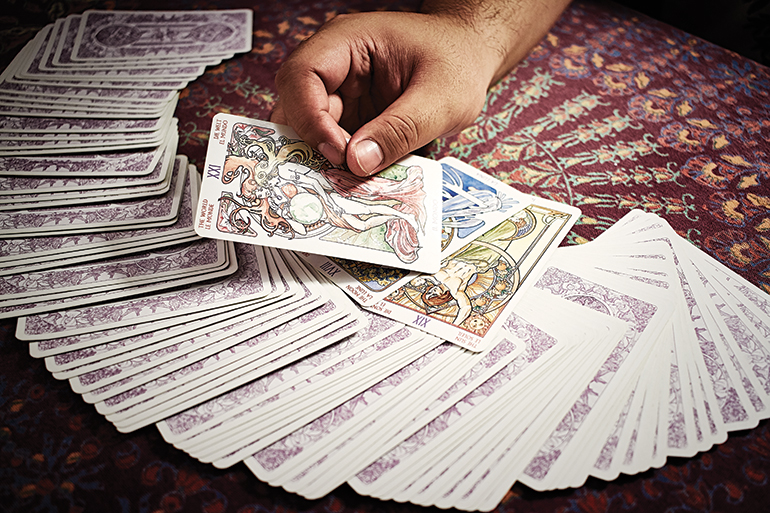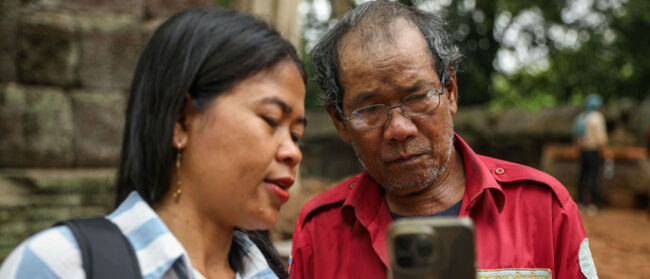In a cramped café in Bangkok’s Nak Niwat precinct, the coffee could be cursed. Not because the stocky, black brew served up to customers at Ace of Cups is unpleasant. It has more to do with the fact that co-owner Atiwan Kongsorn is clawing through bottles of love potions and other magical concoctions that, one presumes, must be consumed along with a liquid.
Kongsorn, 31, is a gregarious, bubbly host as he guides Southeast Asia Globe through the café’s four storeys. On the ground floor is the self-described ‘witch café’, its décor falling somewhere between a hipster’s blueprint and a mad aunt’s attic. Books on Greek philosophy, ancient Mesopotamia and Oriental mythology rest in coves of exposed brickwork and wooden beams. Two cats – one brown with a zodiac collar, and the other a startling white – are perched on shelves, staring long enough at patrons to make them uncomfortable. A sign hanging from a wall reads: “If you don’t have something nice to say, come and sit next to me”.
The upper floors are flush with a heady dose of magic. The walls on the first floor are covered with Buddhist amulets and small, glass jars of potions – reputed cures for everything from impotency to a sore throat. One floor up is a chillout room, where rituals can be performed and herbal remedies consumed. On the highest floor, through a secret bookcase-covered passageway, is where Kongsorn does tarot card reading and performs spells.
“I don’t see magic as white and black. I say it’s either positive or negative. And sometimes in life you have to do the negative, like disciplining children,” Kongsorn says. He adds that he refuses requests from customers to perform a curse against another person, but obliges if they want a curse put on themselves to stop a bad habit.
Kongsorn describes himself as a pagan and a Wicca. Also known as Pagan Witchcraft, Wicca was popularised in the 1950s by a retired British civil servant named Gerald Gardner. It is duotheistic, meaning Wiccans worship two deities, typically Mother Goddess and the Horned God, and it can be described as a neo-Pagan, New Age movement or, in fact, a European form of animism.
In 1999, Kongsorn chanced upon a small social group called Siam Wicca. At the time, it was centred around a basic website that translated articles about Wicca into Thai, and a forum where adherents could discuss their beliefs. A few years later, the swelling ranks of the group gravitated to Facebook, where they created a new group called Thailand Pagan Pride. In 2013, Kongsorn and his friends opened the Ace of Cups café.
Many of those who visit the café consider themselves both Buddhists and Wiccas, including Kongsorn. But when asked why he would adopt a European form of animism when Thailand has its own, and how he sees it fitting in with Thailand’s Buddhist culture, Kongsorn is unable to offer an explanation. Perhaps the question has never dawned on him before. Or, perhaps, it just isn’t very important.
In 2014, Andrew Alan Johnson, an assistant professor of anthropology at Singapore’s Yale-NUS college, published Ghosts of the New City: Spirits, Urbanism and the Ruins of Progress in Chiang Mai, which explored how Buddhist and animist beliefs have been transformed by Thailand’s urbanisation and modernity.
“Globalisation, urbanisation and, especially, capitalism have profound impacts upon small-scale, popular religious practices that we might call animist,” he tells Southeast Asia Globe. “It’s really no surprise; when there are profound changes in how people live their lives and how they see the world, of course they’ll develop a different cosmology.”

One form of this changing cosmology is the introduction of non-native beliefs, such as Wicca. Johnson says it would have been spread by the rise of the internet and the arrival of Western concepts about spirituality and religion that, to some Thais, might appear more cosmopolitan and attractive than local beliefs.
That being said, animism and Buddhism in Thailand have a long history of interaction and appropriation. In 2013, the anthropologist Pattana Kitiarsa published Mediums, Monks and Amulets: Thai Popular Buddhism Today, in which he suggests that for a long time anthropologists viewed magic and superstition as something diametrically opposed to Buddhism. In some ways they are, though this comes down to what some anthropologists call ‘high’ and ‘low’ Buddhism.
In the 1990s, Sulak Sivaraksa, a Thai Buddhist social critic and political scientist, sought to distinguish between what he called Buddhism with a capital ‘B’ and Buddhism with a small ‘b’. The former he considered the state-centred religion in Thailand, dominated by the sangha and closely linked to the ruling elite. The latter was a more societal or cultural understanding of the teachings of Lord Buddha, mostly practised by Thailand’s rural majority, often without the interference of religious structures.
Buddhism with a small ‘b’ can be compared to Pattana’s concept of ‘popular Buddhism’, where “religion converges with the multidimensional structural forces of the nation-state, market economy, modernisation and globalisation.”
Pattana describes popular Buddhism as a “large-scale, cross-social spectrum of beliefs and practices – incorporating the supernatural powers of spirits, deities and magic – that have emerged out of the interplay between animism, supernaturalism, folk Brahmanism, the worship of Chinese deities and state-sponsored Theravada Buddhism”.
Rather than being opposed to animism, popular Buddhism in fact attempts to incorporate many of the superstitions into the faith. In his book, Johnson writes at length about the Pu Sae Nya Sae possession event in Chiang Mai. “This is an old ritual, one where two mediums become possessed by the monstrous spirits of a mountain,” Johnson tells Southeast Asia Globe. The guardian spirits most likely dated from before Buddhism’s entry into Lanna, an Indianised state in present-day northern Thailand that existed between the 13th and 18th centuries. “But the official narrative of the event now places it firmly in a Buddhist context. The story the monks tell is of the Buddha taming and converting these fearsome spirits so that they agree to protect the city rather than menacing its population,” he says.
On the one hand, the appropriation of animist beliefs into the large Buddhist narrative fulfils the role of creating a ‘cross-social spectrum’ which Pattana describes as popular Buddhism. On the other hand, says Johnson, this combination could be a result of animists’ concerns that their beliefs could face disapproval, so they take animist power and give it “a ‘legitimate’ Buddhist face”.
In the 21st century, however, certain animist beliefs not only come up against the hegemony of Buddhism, but also science and reason. At the Pu Sae Nya Sae possession event, Johnson tells of how an announcer said that “science will discover” that these mediums have “nanotechnology”. The meaning of this, Johnson says, is unclear, but what is obvious is “there is an attempt to make mediumship – animism – a part of a scientific worldview in a way that doesn’t diminish it. Is this ‘turning to Western beliefs?’ Not exactly, but it is asserting that there is no conflict.”

Indeed, where animism once attempted to ‘legitimise’ itself by weaving its beliefs into Buddhism, it will also do the same with science and technology. The rise of Asian horror films, for example, has led to new stories of black-haired girls in white dresses menacing Bangkok’s streets, says Johnson. At the same time, Thai cinema has taken centuries-old folkloric spirits, such as the well-known Mae Nak Phra Khanong, which has been the antagonist of dozens of films, and put them into a modern setting.
“Similarly, with the Western New Age, we see people who before might describe themselves as having a guardian spirit instead describe themselves as ‘psychic’ or as practitioners of Wicca,” says Johnson. In other words, the belief is the same, just packaged differently.
Despite the social and technological transformations that have taken place in Thailand for decades, there are few signs that animism is fading. Even the prime minister consults spiritual guides and fortune tellers. And just as animist beliefs were adapted and adopted by Buddhism, and vice-versa, the same beliefs will find a way of expressing themselves within the confines of the modern world.


